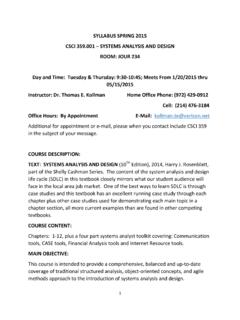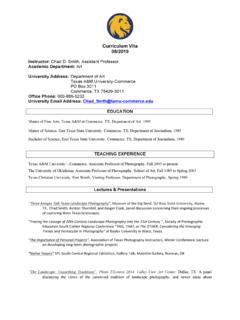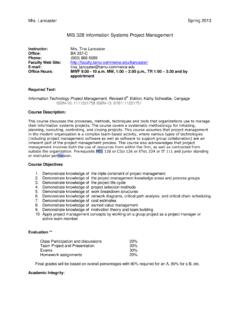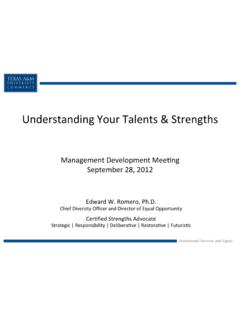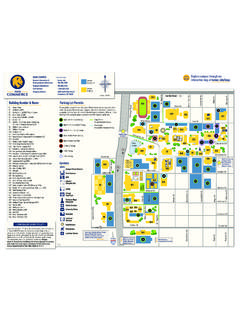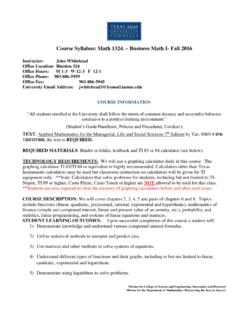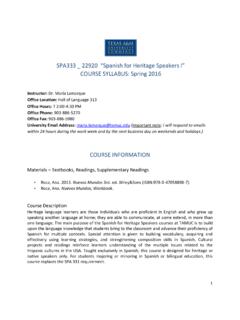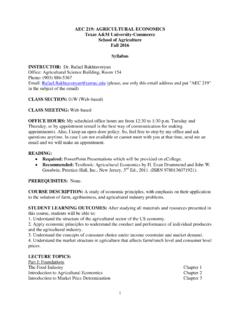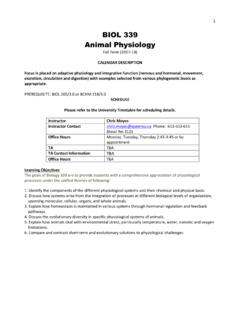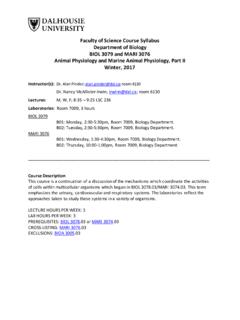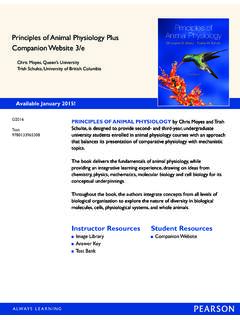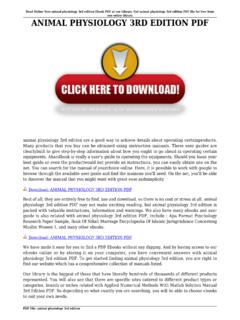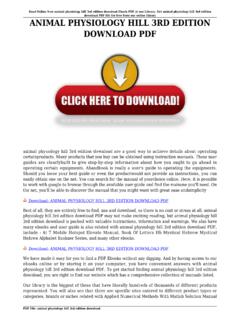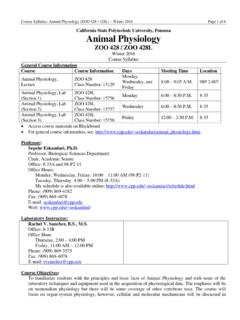Transcription of BSC497: COMPARATIVE ANIMAL PHYSIOLOGY N/A
1 BSC497: COMPARATIVE ANIMAL PHYSIOLOGYCOURSE SYLLABUS: FALL 2013 Instructor: Mark D. Slivkoff, Location: N/AOffice Hours: N/APersonal Cell Phone: 214-799-7388 Office Phone: 903-886-5378 Office Fax: 903-886-5988 University Email Address: INFORMATIONM aterials Textbooks, Readings, Supplementary Readings Textbook(s) Required: Hill, , Wyse, , and Anderson, M. 2012. ANIMAL PHYSIOLOGY , third edition . Sunderland, MA: Sinauer Associates, Inc. ISBN: 978-0878935598 Online access required (directions are posted in eCollege)Course Description:A study of concepts necessary to develop a firm understanding of how both invertebrates andvertebrates are adapted physiologically to the various environments found on our planet. Simplystated, this is a course about how animals--not just humans--work. Prerequisite: college levelbiology. Former course work in PHYSIOLOGY will prove very helpful as well since this is an online(self-directed) Learning OutcomesBy the end of this course students should have the knowledge and skills to:1.
2 Understand how a variety of invertebrates and vertebrates meet their energy demands, digestfood, respire, circulate body fluids, iono- and osmoregulate and respond to environmental changesin temperature and Describe in detail physiological regulation of a particular system at multiple levels of organization( molecular, cellular, organ systems, whole ANIMAL ).3. Provide examples of how recent research in COMPARATIVE ANIMAL PHYSIOLOGY has contributed toour understanding of basic science ( structure-function relationships,acclimation/acclimatizatio n changes) and applied science ( aquaculture, global climate change).COURSE REQUIREMENTSI nstructional Methods / Activities / AssessmentsThis course consists of a series of activities and assessments to assist you in achieving the outcomesfor the course and instructional entire course grade is based on your performance on various assignments. Most assignmentswill require you to answer a set of multiple choice questions (MCQs) whereas other assignments(short essays, case studies) will require you to write short answers and/or mini essays.
3 Eachassignment will therefore not be worth the same number of points. Graduate students will have tosubmit a separate assignment (TBD) based on the primary total number of points possible for each assignment will vary. At the end of the semester, thestudent s grade is determined by calculating the percentage of the total possible points received bythe student. Percentages are then converted to letter grades using the following rubric:Percentage of Total Possible Points Received byStudentLetter GradeGreater than or equal to than or equal to , but less than than or equal to , but less than than or equal to , but less than than REQUIREMENTSThis course is web-based, and will therefore be administered via eCollege (see ACCESS ANDNAVIGATION). All course announcements, which mainly include news about assignments, areposted through eCollege (usually via email). In addition to reading the announcements (my emails),you will be uploading your assignments to the Dropbox.
4 As grades are updated, I update theGradebook. Thus, the three major components used in eCollege are Announcements, Dropbox, following information has been provided to assist you in preparing to use technologysuccessfully in this course. Internet access/connection high speed recommended (not dial-up) Word Processor (Microsoft Word, OpenOffice Writer, et cetera) and Slide Program(Microsoft PowerPoint, OpenOffice Impress, et cetera)Our campus is optimized to work in a Microsoft Windows environment. This means our courseswork best if you are using a Windows operating system (XP or newer) and a recent version ofMicrosoft Internet Explorer ( , , , or ). Your courses will also work with Macintosh OS Xand most Linux distributions. To launch a browser test within any operating system, login in toeCollege, click on the myCourses tab, and then select the Browser Test link under AND NAVIGATIONeCollege Access and Log in InformationThis course will be facilitated using eCollege, the Learning Management System used by Texas A&MUniversity-Commerce.
5 To get started with the course, go to: will need your CWID and password to log in to the course. If you do not know your CWID orhave forgotten your password, contact Technology Services at a Successful Student What Makes a Successful Online Student? Self-Evaluation for Potential Online Students Readiness for Education at a Distance Indicator (READI)o Login Information: Login = tamuc; password = onlineCOMMUNICATION AND SUPPORTI nteraction with Instructor StatementI will communicate with you primarily through your college email address (MyLeo email address). Ifyou email me, expect a response within 24 hours; if I email you, I ll expect a response within AND UNIVERSITY PROCEDURES/POLICIESC ourse Specific ProceduresAcademic Honesty PolicyTexas A&M University-Commerce does not tolerate plagiarism and other forms of academicdishonesty. Conduct that violates generally accepted standards of academic honesty is defined asacademic dishonesty. "Academic dishonesty" includes, but is not limited to, plagiarism (theappropriation or stealing of the ideas or words of another and passing them off as one's own),cheating on exams or other course assignments, collusion (the unauthorized collaboration withothers in preparing course assignments), and abuse (destruction, defacing, or removal) of PolicyOfficial due dates are for each assignment will be announced through eCollege or directly by must be uploaded to the eCollege Dropbox.
6 The format of the file may vary, dependingon the assignment. Please note that for every file you submit, you must have your last name includedin the filename as well as in the WorkLate work will not be a CourseA student may drop a course by logging into their myLEO account and clicking on the hyperlinklabeled 'Drop a class' from among the choices found under the myLEO section of the Web grade ( I ) may be granted under extreme Specific ProceduresADA StatementThe Americans with Disabilities Act (ADA) is a federal anti-discrimination statute that providescomprehensive civil rights protection for persons with disabilities. Among other things, thislegislation requires that all students with disabilities be guaranteed a learning environment thatprovides for reasonable accommodation of their disabilities. If you have a disability requiring anaccommodation, please contact:Office of Student Disability Resources and ServicesTexas A&M University-CommerceGee Library- Room 132 Phone (903) 886-5150 or (903) 886-5835 Fax (903) ConductAll students enrolled at the University shall follow the tenets of common decency and acceptablebehavior conducive to a positive learning environment.
7 (See Code of Student Conduct from StudentGuide Handbook).COURSE OUTLINE / CALENDART here will be numerous sets of multiple choice questions (MCQs) which you will have to completeas the semester progresses. These online MCQs ( online quizzes ) will be available at our textbook swebsite. I will also assign short essay questions and/or case study question Fundamentals of PHYSIOLOGY (weeks 1-3) and Environments: Function on the Ecological and Cells in ANIMAL , Proteomics, and Related Approaches to Development and of Solutes and WaterII. Food, Energy, and Temperature (weeks 4-6) , Feeding, and and Anaerobic Forms of Energetics of Aerobic , Energy, and Temperature at Work: The Lives of Mammals in Frigid PlacesIII. Integrating Systems (weeks 7-8) System Organization and Biological and Neuroendocrine Systems at Work: ANIMAL NavigationIV. Movement and Muscle (week 9) of Movement: The Motor Bases of ANIMAL and Muscle at Work: Plasticity in Response to Use and DisuseV.
8 Oxygen, Carbon Dioxide, and Internal Transport (weeks 10-12) to Oxygen and Carbon Dioxide Respiration: The PHYSIOLOGY of of Oxygen and Carbon Dioxide in Body Fluids With an Introduction to Acid , Carbon Dioxide, and Internal Transport at Work: Diving by Marine MammalsVI. Water, Salts, and Excretion (weeks 13-16) and Salt PHYSIOLOGY : Introduction and and Salt PHYSIOLOGY of Animals in Their and Excretion With Notes on Nitrogen , Salts, and Excretion at Work: Mammals of Deserts and Dry SavannasPlease note the above schedule is flexible, and can change at my discretion.
